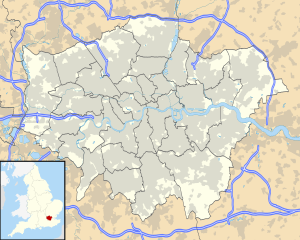Albert Bridge (London)
Coordinates: 51 ° 28 ′ 56 ″ N , 0 ° 10 ′ 0 ″ W.
| Albert Bridge | ||
|---|---|---|
| Albert Bridge | ||
| use | Road bridge | |
| Convicted | Main road |
|
| Crossing of | Thames | |
| place | London | |
| construction | Chain bridge | |
| overall length | 216 m | |
| width | 12.5 m | |
| Longest span | 122 m until 1973, then 55.5 m | |
| start of building | 1871 | |
| opening | December 31, 1872 | |
| location | ||
|
|
||
The Albert Bridge is a road bridge over the River Thames in London . It connects the district of Chelsea in the district of Royal Borough of Kensington and Chelsea on the north side with the district of Battersea in the district of London Borough of Wandsworth on the south side. The bridge is a chain bridge that is 216 meters long and 12.5 meters wide. The span is 122 meters. The bridge is named after Prince Albert of Saxe-Coburg and Gotha and leads the main road A3031 over the Thames.
history
Although parliament had given its approval for the construction in 1864, work did not begin until 1870 in order to coordinate it with the construction of the embankment. The civil engineer in charge was Rowland Mason Ordish . The bridge corresponded to a principle patented by him with a combination of sagging chains similar to the suspension cable of a suspension bridge and inclined chains similar to a cable-stayed bridge . The cost of construction was £ 90,000. The opening took place on December 31, 1872.
In addition to the Albert Bridge, the Albert Bridge Company also owned the neighboring Battersea Bridge . But neither bridge brought in enough toll revenue to cover maintenance costs. In 1878 the Metropolitan Board of Works purchased both bridges and lifted the toll a year later. In 1884 the bridge was strengthened and modernized under the direction of Joseph Bazalgette .
After the Second World War , the bridge proved too weak for the increasingly heavy vehicles. When the London County Council planned to demolish Albert Bridge, there was a huge storm of protest from conservationists, led by John Betjeman . These finally prevailed against the city planners. To save the bridge from collapsing, the foundations were reinforced in 1973, two pillars were placed in the middle of the bridge under the roadway, a lighter roadway was built and the maximum weight of the vehicles was reduced to two tons. In order to make the bridge more visible for shipping, it was given a new coat of paint in an idiosyncratic color scheme.
Web links
Individual evidence
- ↑ Leonardo Ferna Troyano: Bridge engineering: a global perspective . Thomas Telford, 2003, ISBN 978-0-7277-3215-6 , pp. 483– ( limited preview in Google Book search).
- ^ Albert Bridge. In: Where Thames smooth water glide. Retrieved May 26, 2013 .
|
upriver Battersea Bridge |
River crossings of the Thames |
downstream Chelsea Bridge |


